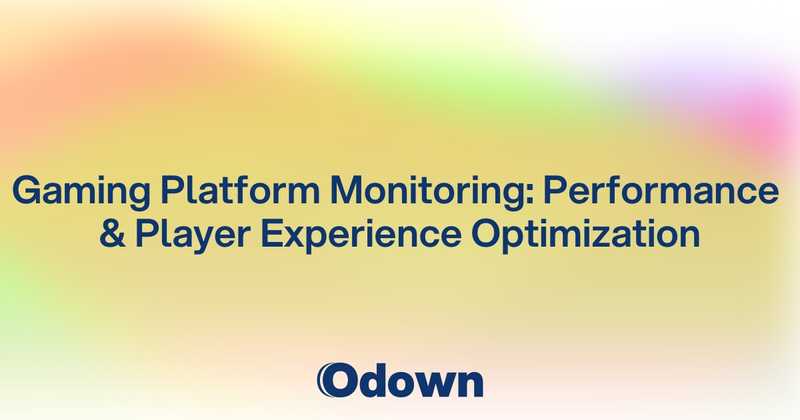Gaming Platform Monitoring: Performance and Player Experience Optimization
Your multiplayer game launches to massive excitement. Pre-registrations exceeded expectations, streamers are showcasing gameplay, and social media is buzzing with positive reviews. Then the weekend hits. Players start complaining about lag spikes during crucial moments. Matches disconnect at the worst possible times. Your perfectly balanced competitive game becomes unplayable due to technical issues that your monitoring didn't catch.
You discover the problem: your monitoring focused on server uptime and basic performance metrics, but missed the player-facing issues that actually determine gaming experience. A 200ms latency spike doesn't crash your servers, but it makes first-person shooters feel broken. Packet loss that barely registers in network monitoring ruins real-time strategy games. Your technical infrastructure was stable, but your player experience was terrible.
Gaming monitoring requires fundamentally different approaches than traditional application monitoring. Players have zero tolerance for performance issues that would be acceptable in other applications. Milliseconds matter. Consistency is more important than average performance. Player experience depends on complex interactions between client devices, network conditions, server performance, and game logic that traditional monitoring approaches can't capture effectively.
Real-Time Gaming Performance Metrics: Latency and Responsiveness
Gaming performance monitoring must track metrics that directly affect player experience rather than just technical system health.
Latency and Network Performance
Gaming latency requirements are orders of magnitude more stringent than typical web applications, requiring specialized monitoring approaches.
Round-trip time (RTT) monitoring tracks the time between player actions and server responses, which directly affects gameplay responsiveness for real-time games.
Jitter monitoring tracks consistency in network timing because variable latency often feels worse to players than consistently higher latency.
Packet loss monitoring identifies network reliability issues that cause gameplay disruptions, character teleportation, and other experience problems.
Network route monitoring tracks how player traffic reaches game servers and identifies routing issues that might affect latency for specific geographic regions.
Quality of Service (QoS) monitoring ensures that game traffic receives appropriate network prioritization over other internet traffic.
Frame Rate and Client Performance
Gaming client performance monitoring tracks how well games perform on actual player devices rather than idealized development hardware.
Frame rate monitoring tracks frames per second (FPS) delivery across different hardware configurations to ensure smooth gameplay experiences.
Frame time consistency monitoring tracks timing stability because consistent 30 FPS often feels better than variable 60 FPS performance.
Input lag monitoring tracks the delay between player input and visual response, which is critical for competitive gaming experiences.
GPU and CPU utilization monitoring on client devices helps optimize game performance across the wide range of hardware that players use.
Memory usage monitoring prevents game crashes and performance degradation caused by memory leaks or excessive resource consumption.
Server Performance for Gaming
Game server performance has different characteristics than web server performance because games maintain persistent state and real-time communication.
Tick rate monitoring tracks how frequently game servers update game state, which affects gameplay accuracy and responsiveness.
Server simulation lag monitoring tracks how well game servers can maintain target update frequencies under load.
Player slot utilization monitoring tracks server capacity and identifies when servers approach limits that might affect gameplay quality.
Game state synchronization monitoring ensures that all players see consistent game state without desynchronization issues.
Resource contention monitoring identifies when multiple games or services compete for server resources in ways that affect gameplay performance.
Platform-Specific Metrics
Different gaming platforms have unique performance characteristics that require specialized monitoring approaches.
Console performance monitoring accounts for the consistent hardware specifications but varying network conditions of console gaming.
PC performance monitoring must account for enormous hardware diversity and different performance expectations across the PC gaming market.
Mobile gaming monitoring addresses unique constraints including battery life, thermal throttling, and variable network connectivity.
Cloud gaming monitoring tracks streaming performance, encoding latency, and input responsiveness for game streaming services.
Multiplayer Game Server Monitoring and Load Balancing
Multiplayer games require sophisticated server monitoring that accounts for real-time communication, stateful gameplay, and player coordination.
Game Session Management
Multiplayer game sessions require monitoring that tracks player connections, session state, and gameplay progression.
Player connection monitoring tracks login success rates, authentication performance, and connection stability for player access to game services.
Matchmaking performance monitoring tracks how quickly players can find appropriate matches and join game sessions.
Session lifecycle monitoring tracks game session creation, progression, and completion to identify issues with game state management.
Player migration monitoring tracks how players move between game servers and regions to optimize routing and server selection.
Game server health monitoring tracks individual server performance and identifies servers that might provide poor player experiences.
Load Balancing and Server Selection
Gaming load balancing must consider geographic distribution, player skill levels, and real-time performance requirements.
Geographic load balancing ensures that players connect to servers that provide optimal latency for their location.
Skill-based matchmaking monitoring tracks how matchmaking algorithms affect server load distribution and player wait times.
Server capacity monitoring tracks available player slots and identifies when additional servers need provisioning.
Auto-scaling monitoring for game servers accounts for the stateful nature of game sessions that can't be interrupted during scaling operations.
Cross-region failover monitoring ensures that players can continue gaming when their primary region experiences issues.
Anti-Cheat and Security Monitoring
Gaming security monitoring must detect cheating and abuse while maintaining the low-latency performance that games require.
Cheat detection monitoring tracks suspicious player behavior patterns that might indicate cheating or exploitation.
DDoS protection monitoring identifies and mitigates distributed denial of service attacks that target gaming infrastructure.
Player authentication monitoring tracks login security and identifies account compromise attempts.
In-game abuse monitoring tracks player behavior and communication to identify harassment and toxic behavior.
Bot detection monitoring identifies automated players that might affect game balance or player experience.
Real-Time Communication Monitoring
Many games include voice chat, text messaging, and other communication features that require specialized monitoring.
Voice chat quality monitoring tracks audio latency, quality, and reliability for in-game communication systems.
Text chat monitoring tracks message delivery and moderation system performance.
Voice processing monitoring tracks noise cancellation, echo suppression, and other audio processing features.
Communication server monitoring tracks dedicated communication infrastructure that supports in-game social features.
Gaming Infrastructure Monitoring: CDN and Edge Performance
Gaming infrastructure requires global distribution and edge computing capabilities that deliver consistent performance worldwide.
Content Delivery Network (CDN) Performance
Gaming CDNs must deliver game assets, updates, and dynamic content with performance characteristics that meet gaming requirements.
Game asset delivery monitoring tracks download speeds and reliability for game installations, updates, and downloadable content.
Patch distribution monitoring ensures that game updates reach players efficiently without overwhelming distribution infrastructure.
Regional CDN performance monitoring tracks content delivery performance across different geographic markets.
Cache hit ratio monitoring optimizes CDN configuration for gaming content patterns and player access behaviors.
CDN failover monitoring ensures that content remains available when primary CDN providers experience issues.
Edge Computing for Gaming
Edge computing enables low-latency gaming experiences by processing game logic closer to players.
Edge server performance monitoring tracks computational capacity and response times at edge locations.
Edge-to-core communication monitoring tracks how edge servers communicate with central game infrastructure.
Player routing to edge servers monitoring ensures that players connect to optimal edge locations for their geographic position.
Edge server scaling monitoring tracks how edge infrastructure adapts to changing player distribution and load patterns.
Global Infrastructure Coordination
Gaming infrastructure must coordinate across multiple regions and providers to deliver consistent worldwide experiences.
Multi-region latency monitoring tracks communication performance between different geographic regions.
Global player distribution monitoring tracks where players are located and how infrastructure load distributes globally.
Cross-provider redundancy monitoring ensures that games remain available when individual infrastructure providers experience issues.
Disaster recovery monitoring validates that gaming services can continue operating during major infrastructure failures.
Mobile and Network Operator Optimization
Mobile gaming requires optimization for cellular networks and coordination with mobile network operators.
Cellular network performance monitoring tracks gaming performance across different mobile carriers and network technologies.
WiFi performance monitoring tracks gaming experience on various WiFi networks that players commonly use.
Network optimization monitoring tracks how games adapt to different network conditions and connection quality.
Carrier relationship monitoring tracks performance agreements and optimization efforts with mobile network operators.
Player Experience Analytics: Engagement and Performance Correlation
Gaming monitoring must correlate technical performance with player behavior to understand how performance affects engagement and retention.
Player Behavior Analytics
Understanding player behavior helps identify how technical performance affects gameplay engagement and satisfaction.
Session length correlation with performance metrics reveals how technical issues affect player engagement and retention.
Player retention analysis combined with performance data identifies technical factors that influence long-term player engagement.
Gameplay progression monitoring tracks how performance issues affect player ability to advance and achieve goals.
Social interaction monitoring tracks how technical performance affects multiplayer engagement and community building.
In-game purchasing correlation with performance helps understand how technical quality affects monetization.
Performance Impact on Engagement
Gaming analytics must quantify how technical performance directly affects business metrics and player satisfaction.
Churn rate correlation with performance issues helps prioritize technical improvements based on player retention impact.
Player satisfaction surveys combined with performance data provide qualitative insights into technical experience impact.
Competitive ranking correlation with performance helps understand how technical issues affect competitive gameplay fairness.
Stream and content creation monitoring tracks how performance affects content creators who promote games through streaming.
Real-Time Feedback Systems
Gaming requires real-time feedback systems that help players understand and adapt to performance conditions.
Network quality indicators provide players with real-time information about their connection quality and expected performance.
Performance recommendations help players optimize their settings and hardware for better gaming experiences.
Server selection tools help players choose optimal servers based on current performance conditions.
Quality adaptation systems automatically adjust game settings based on current performance conditions.
Community and Social Features
Gaming monitoring must track social features that often differentiate gaming platforms from other applications.
Friend system performance monitoring tracks social features that enable player connections and communication.
Guild and clan system monitoring tracks large-group social features that require coordination across many players.
Tournament and competitive event monitoring tracks special events that create unique performance requirements.
Community content monitoring tracks user-generated content systems and their performance impact.
Gaming monitoring transforms competitive advantage from marketing and game design into technical excellence that enables superior player experiences. Instead of hoping that players will tolerate performance issues, you deliver the consistent, low-latency experiences that separate great games from mediocre ones.
The investment in comprehensive gaming monitoring pays dividends in improved player retention, positive reviews, and word-of-mouth marketing that drives organic growth. You finally get the visibility needed to deliver gaming experiences that meet player expectations in increasingly competitive markets.
Ready to optimize your gaming platform monitoring? Odown provides real-time monitoring with the low-latency alerting and global infrastructure visibility that gaming platforms require. Combined with our SaaS monitoring expertise, you'll have monitoring strategies that work for both real-time gaming requirements and scalable service delivery across diverse customer segments.



